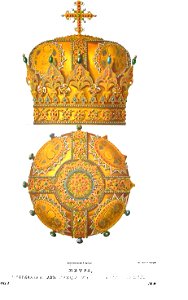Antiquities of the russian country, 1846-1853. V. 1. Illustrator - solntsev, fyodor grigorievich mitra, sent from greece to patriarch nikon this mitra, called a crown in the inventory, according to legend, was sent to nikon from greece, where the name and influence on affairs of the moscow primate were already known. Its form corresponds to this name, and the wealth of various patterns - to its purpose in the patriarchal service, marked by solemnity and magnificence. The base of the mitra is a silver gilded board, on which are placed a crosspiece, cuffs and burls of various precious stones and pearls. At the top, two octagonal stars, inserted one into the other, serve as a footstool for a four-pointed cross of worm-shaped sapphires and emeralds. Around the stars on the enamel rim is depicted from psalm xx, 4: "he set upon his head a crown of precious stone. He asked for life, and of you gave it to him for length of days. The sign of the most blessed patriarch of the great city of moscow and all russia, the lord nikon, 1653. " although the images on the mitre are of greek work and the letters on them are greek, it is not evident from the inscription itself that this crown was sent from greece to patriarch nikon soon after his accession to the episcopal throne. Most likely, it was delivered from the ecumenical patriarchs to one of nikon's predecessors, and by him it was only decorated with precious stones and a greek inscription; because he also imprinted his name on other ancient utensils of his predecessors. Between the crosshairs, on four golden cloaks, or hallmarks, the holy icons are minted and drawn in niello. Evangelists with greek spellings of their names and the beginning of the gospels for each. Above the lower crown rise twelve towns, or burdocks, made of pearls, emeralds and yachonts, representing the likeness of lilies and by their number alluding to the twelve apostles. This mitre weighs 5 pounds. Similar to it and, as is likely, made according to its model, also a forged mitre was a gift to the patriarch from tsar alexei mikhailovich and tsarina maria ilyinichna, as the inscriptions on it and the enamel images of st. Alexis the man of god and mary of egypt, who share their namesake, show. From that time on, gold-plated mitres became widespread, replacing the former soft ones; they were granted as special privileges to bishops and even archimandrites. Date: 1846—1853.
Loading...
